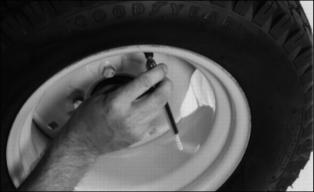Introduction
Product Identification
Safety
Operating
Replacement Parts
Service Interval Chart
Service Lubrication
Service Engine
Service Transmission
Service Electrical
Service Miscellaneous
Checking Tightness of Wheel Bolts
Removing and Cleaning Side Panels
Cleaning and Repairing Plastic Surfaces
Cleaning and Repairing Metal Surfaces
Troubleshooting
Storing Machine
Assembly
Specifications
Warranty
John Deere Quality Statement
Service Record
CopyrightŠ Deere & Company

Service Miscellaneous
Checking Tire Pressure
2. Check tire pressure with an accurate gauge.
Checking Tightness of Wheel Bolts
Check wheel bolts often during the first 100 hours of operation. Tighten every other bolt in sequence until all bolts are at 88 Nˇm (65 lb-ft).
Raising Hood
Removing Grille
1. Lift front of hood up. DO NOT raise hood all the way up.
2. Open and turn the two spring-loaded fasteners (A) to the horizontal position.
Removing and Cleaning Side Panels
2. Open and turn two spring-loaded fasteners (A) to the horizontal position.
4. Hold side panel in an upright position and clean using compressed air or water. Be sure large air intake hole (B) is facing down so dirt and debris can be forced out of panel.
Refueling Machine
IMPORTANT: Avoid damage! Avoid spilling fuel. Fuel can damage plastic and painted surfaces. DO NOT mix oil with gasoline. Unleaded gasoline with an octane rating of 87 or higher is recommended. |
ˇ Use only clean, fresh, UNLEADED REGULAR grade gasoline.
ˇ Remove any trash from top of fuel tank drain area.
ˇ Never use fuel that is stale or has been stored for a long period of time:
Warm Weather: Maximum 60 days.
Cold Weather: Maximum of 90 days.
ˇ Fill fuel tank at the end of each day's operation. This helps to keep condensation out of fuel tank.
Oxygenates (either ethanol or MTBE) are added to the gasoline. If you use the oxygenated fuel be sure it is unleaded and meets the minimum octane rating requirement.
The following are the EPA approved percentages of fuel oxygenates:
ETHANOL (Ethyl or Grain Alcohol): You may use gasoline containing up to 10 percent ethanol by volume.
MTBE (Methyl Tertiary Butyl Ether): You may use gasoline containing up to 15 percent MTBE by volume.
METHANOL (Methyl or Wood Alcohol): You may use gasoline containing up to 5 percent methanol by volume, as long as it also contains cosolvents and corrosion inhibitors to protect the fuel system. Gasoline containing more than 5 percent methanol by volume may cause starting and/or performance problems. It may also damage metal, rubber, and plastic parts of your fuel system.
Filling Fuel Tank
Fill fuel tank at the end of each day's operation. This will help prevent condensation and freezing during cold weather.
1. STOP engine. If engine is hot let it cool several minutes before you add fuel.
2. Remove fuel tank cap (A) slowly to allow any pressure built up in tank to escape.
3. Fill tank only to bottom of filler neck. Approximate fuel tank capacity is 24.6 L (6.5 gal.).
Cleaning and Repairing Plastic Surfaces
Your John Deere dealer has the professional materials needed to properly remove surface scratches from any plastic surfaces, do not attempt to paint over marks or scratches in plastic parts.
1. Rinse hood and entire machine with clean water to remove dirt and dust that may scratch the surface.
2. Wash surface with clean water and a mild liquid automotive washing soap.
3. Dry thoroughly to avoid water spots.
4. Wax the surface with a liquid automotive wax. Use products that specifically say "contains no abrasives."
5. Buff applied wax by hand using a clean, soft cloth.
Cleaning and Repairing Metal Surfaces
Cleaning:
Follow automotive practices to care for your vehicle painted metal surfaces. Use a high-quality automotive wax regularly to maintain the factory look of your vehicle's painted surfaces.
Repairing Minor Scratches (surface scratch):
1. Clean area to be repaired thoroughly.
2. Use automotive polishing compound to remove surface scratches.
3. Apply wax to entire surface.
Repairing Deep Scratches (bare metal or primer showing):
1. Clean area to be repaired with rubbing alcohol or mineral spirits.
2. Use paint stick with factory-matched colors available from your John Deere dealer to fill scratches. Follow directions included on paint stick for use and for drying.
3. Smooth out surface using an automotive polishing compound. Do not use power buffer.








